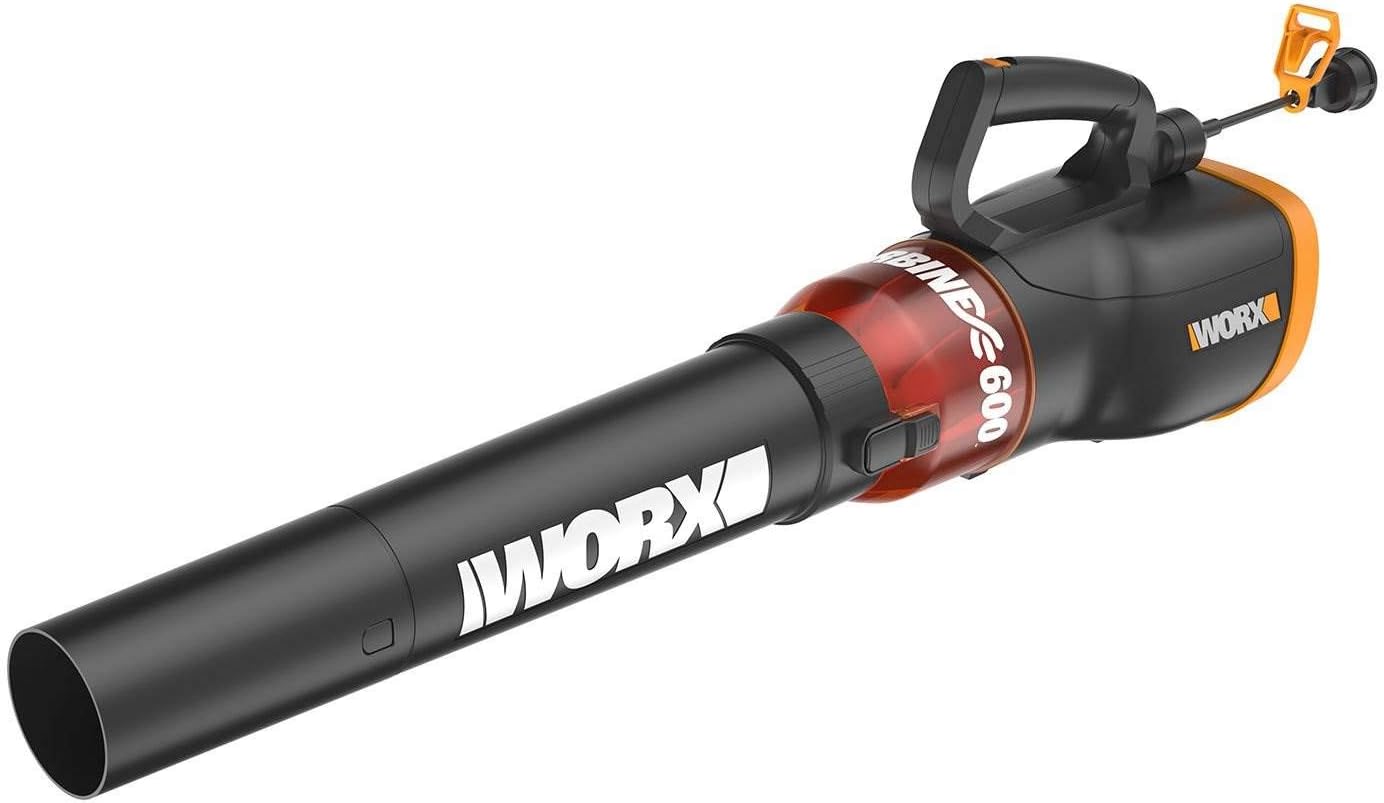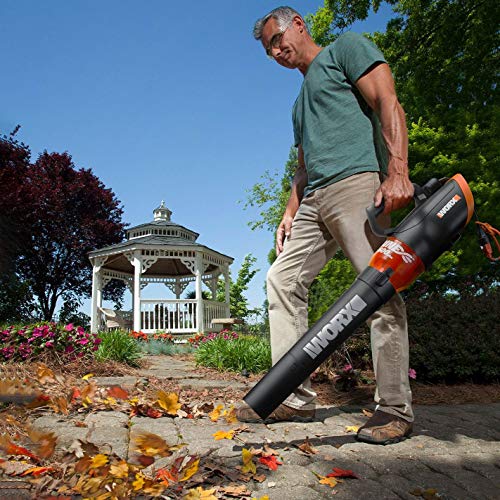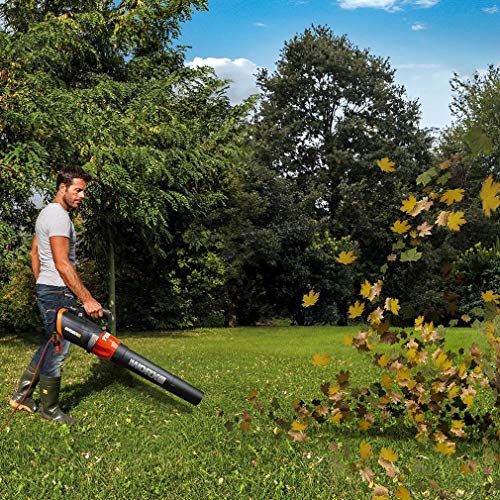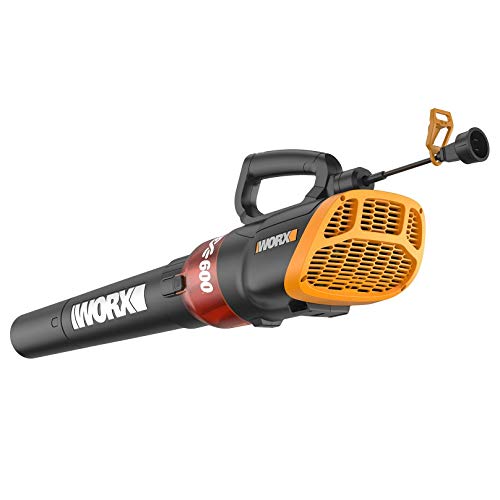
Original price was: €79.99.€63.94Current price is: €63.94.
WORX WG520 12 Amp Turbine Leaf Blower Price comparison
WORX WG520 12 Amp Turbine Leaf Blower Price History
WORX WG520 12 Amp Turbine Leaf Blower Description
WORX WG520 12 Amp Turbine Leaf Blower: Power and Efficiency in Your Hands
Introducing the WORX WG520 12 Amp Turbine Leaf Blower, the ultimate tool for effortless yard maintenance. With its lightweight design and powerful features, this electric leaf blower is perfect for homeowners looking to quickly clear leaves and debris. Discover why this model is a top choice in the market and how it can simplify your outdoor chores.
Key Features and Benefits of the WORX WG520
- Powerful Air Flow Capacity: With an impressive air flow rate of 600 cubic feet per minute (CFM), the WORX WG520 can handle even the most stubborn piles of leaves. This high capacity ensures that you can complete your yard work in no time.
- Adjustable Speed Settings: Choose between two speed settings for maximum control over your cleaning tasks. Whether you need a gentle breeze for delicate flower beds or a powerful gust for heavy debris, this blower has you covered.
- Lightweight Design: Weighing in at just 6.5 pounds, this handheld blower is easy to maneuver for extended periods. No more exhaustion after a short cleanup session!
- High Maximum Air Speed: The blower boasts a maximum air speed of 110 miles per hour, providing you with the velocity needed to tackle tough messes efficiently.
- Durable Construction: Made from Acrylonitrile Butadiene Styrene (ABS), the WG520 is designed for longevity, ensuring reliable performance season after season.
Price Comparison Across Multiple Suppliers
The WORX WG520 12 Amp Turbine Leaf Blower offers competitive pricing across various retailers, making it accessible for homeowners on a budget. Typically, you can find this blower priced between $99 and $129, depending on the seller. Our price comparison tool will help you find the best deal available, so you can save money while investing in a reliable yard maintenance solution.
Price Trends: Insights from 6-Month Price History
Over the past six months, the WORX WG520 has shown a steady price trend, with occasional promotions offering discounts during peak buying seasons. This consistent pricing pattern makes it easier for consumers to plan their purchases. Historically, you can expect to see the prices dip during holiday sales, particularly around Black Friday and spring gardening season.
Customer Reviews: Pros and Cons of the WORX WG520
Customers have praised the WORX WG520 for its lightweight nature and powerful performance. Many users appreciate its ease of use, especially for those who may not have the strength for heavier gas-powered alternatives. The adjustable speed feature has been highlighted as a significant benefit, allowing for tailored performance based on specific tasks.
However, some customers have noted that while the blower works exceptionally well for leaves, it may not be as effective on heavier debris like wet leaves or small twigs. Additionally, a few users mentioned that the cord length of 11.5 feet could be limiting for larger yards, requiring extension cords for extensive areas.
Watch Reviews and Unboxing Videos
If you want to see the WORX WG520 in action, check out the available unboxing and review videos on platforms like YouTube. These videos provide a visual demonstration of its features and will help you understand how it performs in real-world scenarios. Hearing from other satisfied users can give you the confidence needed to make this purchase decision.
Final Thoughts: Why You Should Choose the WORX WG520
The WORX WG520 12 Amp Turbine Leaf Blower combines power, efficiency, and ease of use, making it an excellent investment for any homeowner. With its remarkable airflow capacity, adjustable speeds, and lightweight design, yard cleanup has never been easier. As you compare prices, consider the overall value the WG520 brings to your gardening toolkit.
Don’t miss out on the chance to enhance your outdoor maintenance routine. Compare prices now!
“`
WORX WG520 12 Amp Turbine Leaf Blower Specification
Specification: WORX WG520 12 Amp Turbine Leaf Blower
|
WORX WG520 12 Amp Turbine Leaf Blower Reviews (5)
5 reviews for WORX WG520 12 Amp Turbine Leaf Blower
Only logged in customers who have purchased this product may leave a review.












D. Alexander –
This is one of the most powerful handheld electric blowers available. If you’re serious about getting the job done quickly, this is the baseline. The next power tier is a gas backpack blower at five times the cost, then an even more powerful backpack, and then four-digit specialty tools from companies like Billy Goat. I bought the Worx because I didn’t want to spend three hours raking a half-acre of grass.
My trial run was an hour of continuous use with matted wet leaves and driveway sand. It fast became apparent that to be efficient, a blower has to move leaves without being on top of them. Blowing from six inches just makes everything scatter as piles build up. You end up crisscrossing the section you just cleared to deal with the strays. The further your breeze carries, the more direct the flight path of the leaves. This range, and the ability to scour stubborn leaves from the ground, comes from air speed (MPH). At the same time, though, you need a big enough wall of air to move more than one leaf at once. That comes from the size of your pipe opening. The two multiplied together determine your total air volume over a duration, or CFM (cubic feet per minute).
In physics-land (with spherical cows and turbulence-free pipes, spared from the icy hand of marketing), CFM is the best measure of a blower’s work capacity. MPH, you can change by varying the size of the pipe; a smaller pipe makes a smaller column of air moving at a faster speed (and more impressive advertising), which is why a lot of consumer-class blowers have tiny nozzles. (I’m looking at you, Sun Joe SBJ601E.) But there’s a cost to adding MPH: it kills efficiency. The energy to move a volume of air goes up with the square of speed, so if you design your blower for 160 MPH, you’ll get half the CFM of a 110 MPH blower from the same power. Something to mull if the blower is powered by a battery.
Still, if you know either speed or CFM, and the size of the pipe, you can calculate the other (assuming the manufacturer isn’t misleading you by quoting CFM at the fan and MPH at the end of the pipe). To get CFM from MPH and the radius of a round pipe, the calculation is (radius^2)*(mph)*(1.92). That’s (1.69^2)(110)(1.92) for this blower’s 110 MPH and 3 3/8″ pipe, with the result arriving right at the rated number of 600 CFM.
Anyway, the Worx has enough volume and speed to blow mounds of wet leaves from six feet and dry ones from ten or more. It’s impressively powerful. I was switching arms every few minutes as they wore out from the backward force. Only some really baked-on mud would have benefited from a pipe-reducer attachment. Thanks to ape-like proportions or the secure fit of my spandex leaf-blowing onesie, clothing suction from the rear-directed air intake hasn’t been a bother.
ALTERNATIVES:
I almost bought Toro’s highly-rated “Ultra” combination blower to minimize bagging, but the vacuum functionality didn’t seem that useful in videos. Maybe it’d be adequate to clean an enclosed deck area or a small yard with a scattering of dry leaves. For a larger yard, it looks like a time sink relative to a standalone mulcher. Likewise the blowing capacity, which, at 410 CFM, trails the Worx by quite a lot.
Cordless tools were also tempting. There’s a 20V DeWalt people seem to like that’s rated at (a perhaps optimistic) 400 CFM. Because it’s a similar fan design to the Worx, we can compare power directly. DeWalt’s standard battery is 20V (or so we’ll stipulate; it’s closer to 18V under load) and 5 amp-hours, so we’re looking at 100 watt-hours total output. 15 minutes of runtime translates to a sustained draw, best case, of 400W. Assuming 90% efficiency in the brushless motor, that’s 360W actually moving air. (When new. Expect a performance drop over time and battery replacements by year three.)
Compare this Worx: 12 amps at 120V equates to 1440 watts sustained, in this case feeding a 2-pole AC/DC motor that’s perhaps 55% efficient. 12A is close to the maximum a device can reasonably expect from a typical 15A household socket. Even with nearly half of our power lost to heat and noise, the remaining 790W is over double what the DeWalt can manage. It’s no coincidence that 600 CFM cordless blowers (Greenworks and Kobalt come to mind) have 80V/2.5Ah batteries with twice the DeWalt’s capacity. Their runtime at full tilt? The same fifteen minutes, with three extra pounds to lug around from a chunk of lithium that costs more than the blower it attaches to.
And what of gas blowers? The handheld versions have around 1 HP with CFM from 450 to 500. They’re usually tuned for higher MPH than the Worx, so they’re likely to be a little better with wet leaves and a little worse with dry ones. Backpack blowers up the displacement and make between 1.5 and 5 horsepower. The models that you might find on the back of a professional landscaper can manage nearly 1000 CFM with speeds around 200 MPH. That’s a considerable difference, but you pay for it at the checkout and in weight: figure 10 pounds or so for a handheld (relative to 7ish for this unit, plus some cord) and 20 or more for a backpack.
As of mid-2020, two other corded blowers are worth a hard look: Toro’s F700 and Worx’s WG521. The Toro arrived first in 2019 with a hefty 720 CFM rating, a bigger two-arm handle, and a better cord retention mechanism. The WG521 is the response: 800 CFM and 135 MPH (claimed) from a ~4″ nozzle, albeit still intended for one arm. All three blowers are beastly and often close in price; pick whichever best channels your inner Tim Allen.
ACCESSORIES:
A motor this powerful benefits from a thick (low gauge) cord for longer runs. You lose a bit of performance with thinner cord. The generic orange 50-foot extension everyone has is 16-gauge. Feeding a 12A load for 50 feet, it’ll have a voltage drop of about 5V. Heavier 14-gauge loses 2.5V on the same run, and industrial 12-gauge, only 1.5V. The scale is linear, so if you double up that 16-gauge cord for a 100-foot run, you’ll lop off 10V.
How’s that play out here? From a short and fat cable (that the cheesy plastic strain-relief piece won’t actually accommodate; just tie an overhand knot over the two plugs instead), we’d expect a 1440W draw (12A * 120V, or a bit less because the house wiring itself has some drop). Losing 5V drops the total to 1380W. That’s about what I found when I tested the Worx with a watt meter.
12ag / 3 ft = 1423W
14ag / 100 ft = 1352W
16ag / 50 ft = 1351W
16ag / 50 ft + 14ag / 100 ft = 1280W
With the progressive thumb dial at the lowest setting, minimum draw was 260W.
For shorter runs, disconnect extensions you don’t actively need. Every cable sheds a percentage of the energy it carries to heat. As above, skinny cables lose more. Coiled on the ground and coupled with a high-load device like the Worx, they can build up enough heat to start melting insulation, which tends to cause sheepish expressions and insurance claims.
This blower is also loud enough to merit hearing protection. On an A-weighted scale (approximating human hearing), measured outdoors from three feet, it makes 82 dB on low and 91 dB on high. Indoors or near a wall, volume jumps by 10 dB and subjectively doubles. While the sound character emulates a vacuum, my Shark only measures 72 dB indoors; you’d have to run over a rat’s nest of lamp cords to make one this loud. Amazon has a number of comfortable muffs for less than a Jackson that’ll keep your ears intact.
You can find electric blowers with more toys, but few that’ll get the job done as fast as this one. It’s a bargain at the asking price. I’ll update if I catch any reliability problems.
D. Jenkins –
This is my 4th leaf blower, its much lighter and more powerful than the battery ones. It rates 600 cfm and theres no doubt thats what it delivers. At 2 settings you can bring it down to 450 cfm if need be. Quality built. Its the best i have seen in its category. Definitely reccomend.
Tim Weintraut –
Let me tell you that I have rock desert landscaping. I have the worst tree that drops these twisted seed pods that get caught in the rocks. I tried a couple cordless blowers and they ran out of battery life too quick . They also lacked the power to clear the seed pods. Not a problem with the Worx .blower. Get the right tool for the job and it makes the job simple.. The Worx blower is definitely the right tool. Great price, lightweight balanced well and not too loud. Adjustable air flow dial.
Tim Weintraut –
For the price, this blower is very good. I had a WORX blower and mulcher, previously, that worked well, but this blower does the one thing better. I do miss the mulcher, but not the extra weight. This stand-alone blower is about 3 pounds lighter and more powerful; though, the all-in-one had more precise airflow, for the few small spots that it was beneficial for me.
The build quality is so-so on this blower. It lacks what we all appreciate in our tools and devices—that sharp snap and click and clean fit when putting the pieces together. The hose attaches to the body with an imperfect and never fully flush connection. It’s not going to go anywhere—it does have a latch. The pieces are not as rugged and solid as my previous WORX all-in-one, but I can guess that’s what helps reduce the weight. Speaking of, I had considered the WORX WG547, cordless blower, for the weight reduction and convenience of no cord, but I was concerned with loss of power, limited usage time, and higher cost. After using this WG520 for the first time, I do desire a lighter machine, but I think I would miss the extra power and limitless usage time. If budget was not an issue, I probably would’ve gone with the WG546—which is a step up from the cordless WG547 I was considering—with an extra battery; but that is 3-4 times the cost of this WG520. But even that blower could not match the power of this one. It’s worth noting that that power comes from a large air intake on the back that can suck in loose clothing.
Cost was the number one priority for me; so I was pleasantly surprised when I found that on this low-budget machine there are variable speeds, ranging between the low to high speeds. If cost is the number one priority for you as well, without having to lose too much power capability, I can easily recommend this WG520 WORX blower.
Chris –
The WORX WG520 12 Amp Turbine 600 Electric Leaf Blower is a standout tool for yard maintenance, offering a blend of power, efficiency, and ease of use. Multiple speed options is a game changer. Its craftsmanship and materials are top-notch, with durable construction that feels robust and built to last.
The 12-amp motor delivers impressive power, generating strong airflow that makes quick work of leaves and debris. With its turbine fan technology, the blower provides consistent performance and high airspeed, which significantly enhances its effectiveness in clearing large areas. Despite its power, the leaf blower is relatively lightweight, making it comfortable to handle and maneuver for extended periods.
Overall, the WORX WG520 excels in performance and durability, and its user-friendly design makes it a valuable addition to any homeowner’s toolkit. I’ve recommended this blower to many friends and colleagues, all of whom have been equally impressed with its efficiency and reliability.